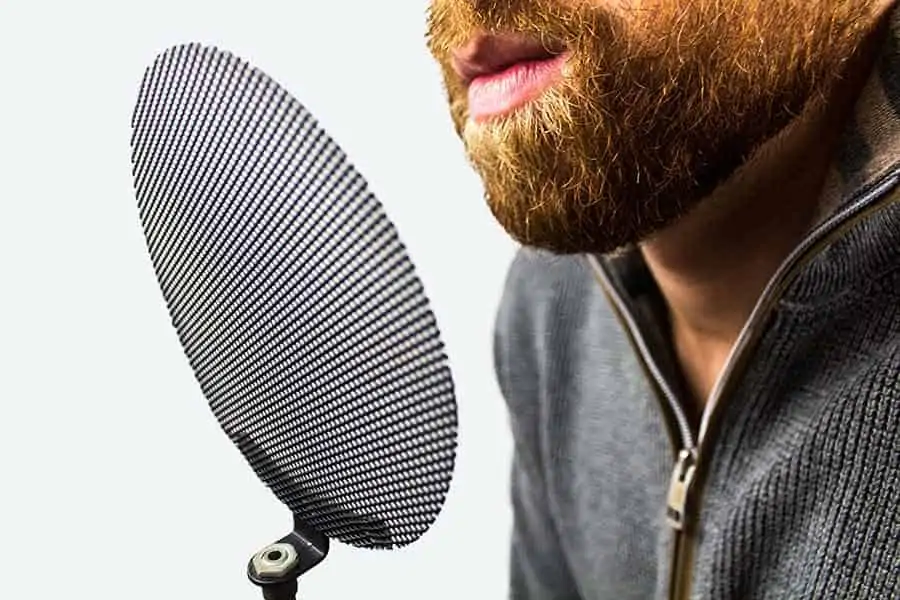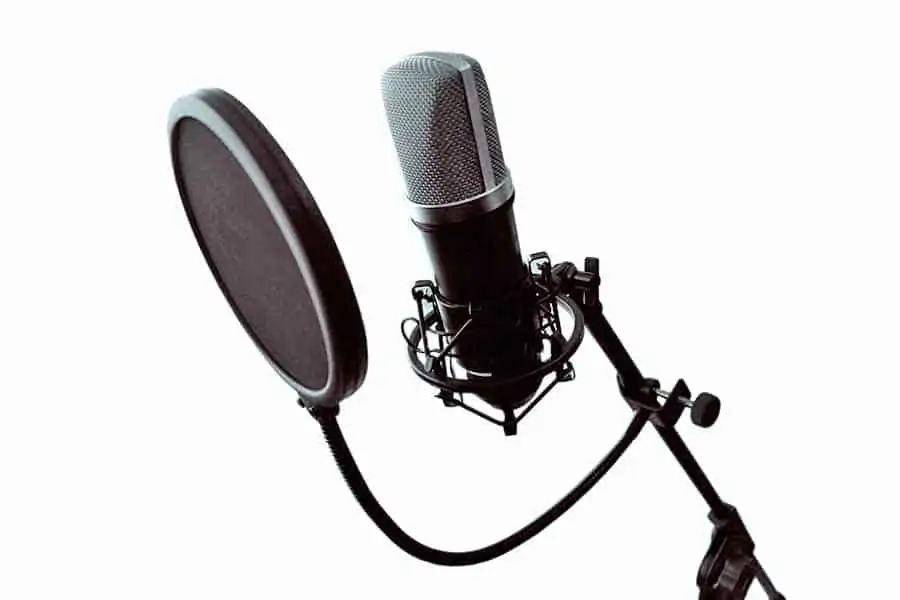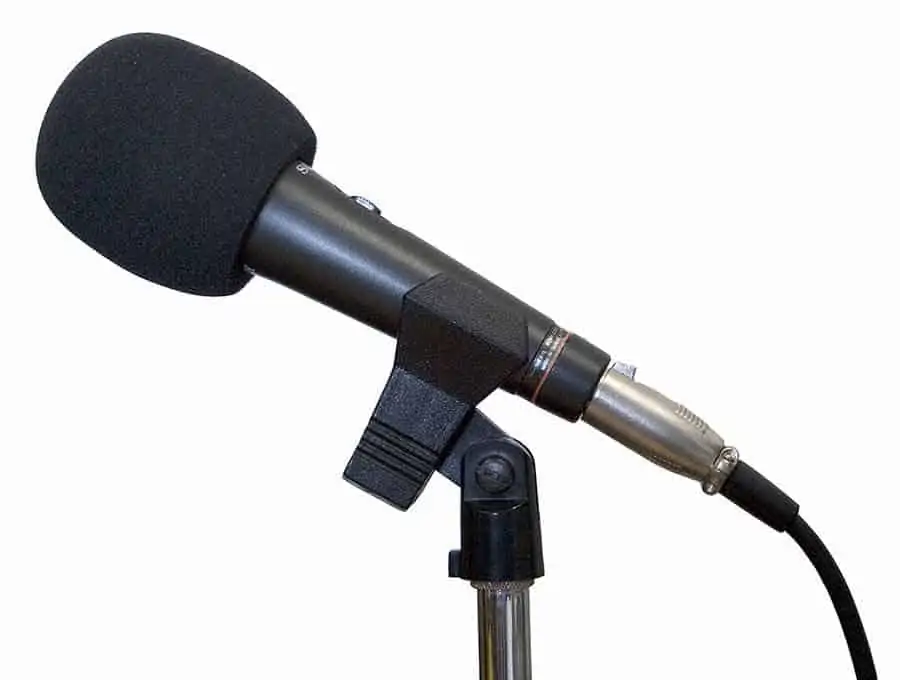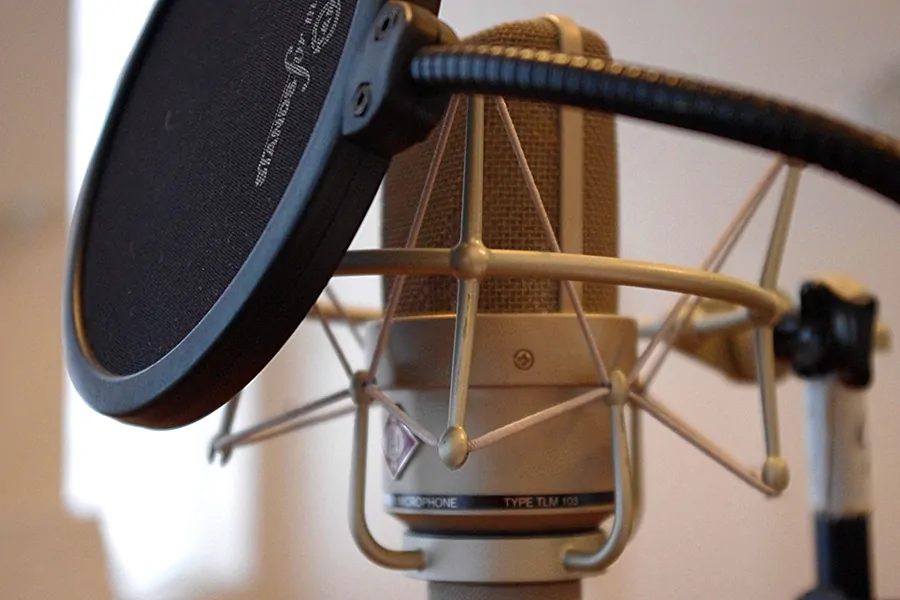We’re an affiliate: We hope you love our articles and the products we recommend! Just so you know, when you buy through links on this site, we may earn an affiliate commission. Thank you if you use our links, we really appreciate it!
Today I’m going to explain what is a pop filter for a microphone is.
In fact, not only will I explain what is a microphone pop filter I’ll also explain when and how to use it properly.
But I want to mention something first.
This answer to what is a microphone pop filter isn’t going to be hyper-technical. I’ll try and make it super straight-forward and even recommend some pop filters at various price points.
IN A HURRY? If you’re in a hurry skip straight to my pop filter recommendations by clicking here. Or check out the microphone pop filter best sellers on Amazon below.
Last update on 2023-09-22 / Affiliate links / Images from Amazon Product Advertising API
What is a microphone pop filter?
Mic pop filters are also known as pop shields and pop screens.
They are most often used in recording studios, radio stations, and voice recording booths to cut certain unwanted breath noise.
Although they are filters, they are not an electronic filter in an audio recorder or a software filter in a Digital Audio Workstation (DAW).
So, what is a pop filter for a microphone?
In short, pop filters are physical devices that are made from sonically transparent material, usually foam or mesh. They are positioned between the microphone and the performer, normally a few inches in front of the microphone.
What does a microphone pop filter do?
A microphone pop filter is a physical device that is designed to stop or at least reduce the popping sounds caused by vocal plosives.
In an audio recording, plosives are the sudden bursts of fast-moving breath air that hits a microphone’s element or diaphragm.
Sounds normally move through the air by gas molecules nudging neighboring molecules to pass on the sound vibration. This vibration of air molecules does not involve the mass movement of air since there is no shift in the average position of the air molecules. And the amount of energy in the sound wave is relatively low.
But when it comes to plosives in speech or singing, there is a sudden burst of breath from the mouth, which carries a much higher amount of energy.
This mass movement of air causes a wind blast causing a sudden and large pressure change at the microphone’s element or diaphragm. It’s that sudden pressure change that produces the low frequency “thump” sound that is typical of vocal pop or blast.
So, in answer to what does a pop filter do for a microphone, it protects it from picking up the low-frequency thumps. Those noises that would otherwise ruin a recording, or at least cause you to have a lot of post-production work to eliminate the popping.
When do you produce plosives?
You produce plosives in speech or singing on certain consonant sounds. These are primarily P, B, and T, although other consonants, such as K may also cause problems.
You can easily demonstrate for yourself how these consonants create mass air movement.
Hold the palm of your hand about 4 to 6 inches (10-15cm) in front of your mouth and recite the opening line from this well-known nursery rhyme.
“Peter Piper picked a peck of pickled peppers“.
You should notice hardly any sense of wind hitting your palm while you spoke, “Mary hand a little lamb”. But on each of the “Ps” in “Peter Piper picked a peck of pickled peppers”, you should have felt your breath on your hand.
It’s those large air movements striking the microphone that cause those recorded pops and blasts.
Mic pop filters are designed to stop the microphone’s element or diaphragm “feeling” the wind or breath blasts in a performer’s speech or singing.
You can use foam-type windscreens outdoors, but you would normally use pop filters indoors for recording vocals, podcasts, and vlog-type videos.
Now that you know the answer to what is a microphone pop filter we look at the types of pop filters that will be of most use in your voice recordings.
The types of pop filters available
There are three types of pop filters used with microphones for recording spoken voiceovers and vocal singing. These are Metal Mesh pop filters, Nylon Mesh pop filters, and Foam Windscreen pop filters.
Metal Mesh Pop Filter

As the name suggests, the mesh is formed from a metal mesh. The mesh is normally a circular disk or a curved U-shape. Of the three types of pop filters, the metal mesh is likely to be the most expensive, ignoring branded foam windscreens for high-end microphones.
The Stedman filter is a good example of metal mesh pop filters where the mesh is designed to deflect the air or windblast down and away from the microphone while allowing the vocal sound passes through.
If you try blowing through a Stedman pop filter you won’t feel the air passing directly through but below the filter. But if you move your hand downwards the diverted airflow will become apparent.
Nylon Mesh Pop Filter

These types of pop filters are usually circular disks. They use a nylon type material stretched across a metal or plastic ring, with one or two layers of nylon mesh.
Instead of directing the air away from the microphone the intention is to diffuse and slow down the air. This prevents the windblast from striking the microphone and so the plosives are reduced or stopped.
Foam Windscreen Filter

Many people consider foam windscreens to be pop filters. However, most cheap windscreens are ineffective at stopping microphone pops and blasts. They are usually only effective at preventing moisture reaching the sensitive parts of a microphone.
Many of the more expensive foam windshields are more effective at reducing popping from breath plosives. They tend to be larger and sometimes consist of two or more types of open-cell foam material sandwiched together.
The foam windscreen filters fit snuggly on the microphone, so you will need one that fits your microphone.
So, what does a microphone pop filter do when you choose a foam windscreen type?
These work in a similar fashion to the nylon mesh pop filters in that they diffuse the air rather than diverting the high-pressure air away from the microphone.
Although the foam is meant to be sonically transparent, often foam windscreens dampen or reduce higher frequencies more than the mesh microphone pop filters.
This high-frequency reduction effect might be more noticeable with female performers since they tend to have higher voices than men.
For more details about how to stop microphone popping read my article about 7 different ways to prevent audio pops.
Can you use a pop filter and a windscreen at together?
You can use a foam windscreen on your microphone and a mesh pop filter. However, the more material you place between the sound source and the microphone the more likely you will affect the quality of the sound.
Since higher frequency sounds are more easily affected by physical barriers, using too much “stuff” in the way of your performer can dull the sound of their voice.
So only use as much microphone protection as is necessary and no more.
How to set up a pop filter
1: Mesh pop filters
Let me explain how to set up a pop filter properly because in the 30+ years I’ve worked in radio and voiceover studios I’ve oftentimes seen pop filters being used incorrectly.
The first thing to avoid is placing the mesh pop filter right up against the grill of your microphone. This just won’t work.
You need a little space between the microphone and the pop filter to allow the air blast from your plosive “Ps” and “Bs” to disperse.
I normally recommend about 2 to 3-inches (5-7.5cm) between the mic and the pop filter. If in doubt, that’s about three fingers width.
To get the distance right pull down your “pinky”, then put your “ring” finger against the microphone’s grill. Now move in the pop filter until the mesh touches your index finger. It’s all part of learning how to set up a pop filter but your pop filter should now be in the ideal position.
Most mesh pop filters come attached to a gooseneck. The cheap ones terminate in a simple sprung clip mount. In my experience that isn’t highly effective and does not “anchor” the gooseneck in place. You want a mounting clamp that can be fixed firmly in place.
The gooseneck should also be firm but flexible. You need to be able to move your mesh pop filter into place and for it to stay there. I’ve seen people fiddling with their filters for ages trying to get the filter to stay in place. It’s a waste of time and doesn’t get you the results you are after. The solution is to make sure you have a decent quality gooseneck and mounting clamp.
Next, you need to know where to position yourself.
Move in until your mouth is about 3 to 10-inches (7.5-25cm) from the pop filter, and make sure you are facing towards the microphone. If you ignore the filter, you should be 6 to 12-inches (15-30cm) from the microphone.
With this set-up, the mesh pop filter is closer to the microphone’s capsule than it is to your mouth. This extra distance gives the air blast from your mouth a chance to dissipate slightly before the pop filter needs to do its job of killing the voice pops. However, you are still able to get close enough to the microphone to take advantage of the mic’s proximity effect and add that nice bass effect to your voice.
The above set-up is fine provided you are recording song vocals or a normal voiceover for a video or advertisement, but if you’re recording a podcast or an interview and want a more natural sound, stay 10 to 12-inches from the microphone.
2: Foam windscreen pop filters
If you are using a foam windscreen pop filter on your microphone you have no opinion but to put the foam windscreen right on the mic. It’s the way they are designed to work.
You can buy generic foam filters, but some microphones have windscreens that are specifically designed for them. So, you may find it is either quite easy to slide on the foam or it might be a tight fit.
You should now position yourself about 6 to 12 inches (15-30cm) from the microphone for a normal voiceover recording. Again, speak directly towards the microphone, although you may need to adjust your mic technique if you still experience some popping.
If you want to create those deep rich voiceover recordings, like late-night radio presenters, the foam windscreen will probably be your favored choice of pop filter. The foam allows you to get right up close to the microphone and exploit its proximity effect, assuming it has one.
If you use either of the two setups mentioned above, you should now understand how to set up a pop filter properly and be good to go. But remember that no single pop filter will stop absolutely every plosive. So, if you still experience some popping you may need to alter your mic technique, your enunciation, or diction. Again, you may find my article about how to stop microphones from popping useful.
DIY pop filters – How to make a mic pop filter
Although you can buy professionally made pop filters you can easily learn how to make a mic pop filter at home or in the office.
The easiest mesh pop filter you can make is to stretch some pantyhose over a wire coat hanger. Yes, I know, it doesn’t look pretty, but it does work. Although you may get some strange looks from your girlfriend or wife if you ask them for an old pair of their pantyhose!
You can step up your game by making a filter that even looks quite professional. It involves using an embroidery hoop.
I have worked in recording studios where the audio engineers stretched nylon pantyhose material over embroidery hoops. These DIY pop filters worked very well, although mounting them required a little extra DIY skill.
Once you have added an appropriate mount you can then attach the DIY microphone pop filter to a flexible gooseneck or mic stand. Place the pop filter in front of your microphone and try it out, it should work fine.
One DIY pop filter you should try and avoid is a plastic or metal sieve from your kitchen. It simply doesn’t work on a couple of levels.
First, it’s the wrong type of mesh to work effectively at killing those plosives. It’s most likely a woven metal wire mesh that is not designed to divert the airflow. And second, the fact that the shape is hemispherical means you have no control over how close (or far) you position the sieve from the microphone. With a flat mesh, you can place the filter exactly where you want it.
Which microphone pop filter should you buy?
Now that we know the answer to our earlier question of “what does a microphone pop filter do?”, we are better placed to understanding which type to buy.
However, do not expect even the most expensive pop filter to be 100% resistant to every vocal pop or blast.
Under normal voice recording conditions, pop filters are highly effective. But if you force the plosives, like in beatbox, the pop filter merely prevents moisture from entering the microphone. It will not stop the thump sound produced by the vocalist.
Metal Mesh Pop Filters
In my experience, metal mesh pop filters are extremely effective at eliminating plosives. But more importantly, I also like the sound that they produce or the lack of any effect on the sound of the performer’s voice.
Furthermore, my choice of filters, even the budget-priced one, have good sturdy mounting clamps. You should find that none of them will flop around.
Steman Proscreen XL pop filter
The Steman Proscreen XL pop filters is a 6-inch diameter filter on a 13-inch gooseneck that can be clamped to your mic stand. Despite being at the top end of the price range the performance is excellent, producing a nice crisp sound.
The louvers deflect air away from the mic capsule. But make sure you center the mic behind the filter and do not place the filter too close to the mic.
Since the Stedman Proscreen XL pop filter is metal is easy to wash clean and certainly outperforms the nylon mesh filters I have tried. It’s also durable and should last a good length of time. The Stedman pop filter is made in the USA.
- Screen diameter: 6"
- Length: 26.5"
- Weight: 10 oz.
- Clamp range: .39"
Last update on 2024-03-10 / Affiliate links / Images from Amazon Product Advertising API
Pro Metal Filter by SE Electronics
Like the Stedman, the Pro Metal Filter by SE Electronics is a pro-grade piece of kit and is ideal for recording voiceovers and podcasts.
It is 6-inches in diameter and comes on a flexible but firm gooseneck.
The holes are slightly convex to redirect low-frequency air blasts to the side of the screen, without dampening high frequencies. You really do hear your talent’s true performance.
The SE Electronics Pro Metal Filter is durable and is designed to last as well as being a superb performer.
- Unique metal screen
- Long life span
- Gooseneck holds its position at any angle
- Slightly convex shape to redirect low-frequency air blasts to the side of the screen
Last update on 2024-03-10 / Affiliate links / Images from Amazon Product Advertising API
Nylon Mesh Pop Filters
Some audio engineers prefer nylon mesh type pop filters. They believe diverting too much air from the microphone produces an unnatural sound. However, it can also be claimed that nylon mesh pop filters can attenuate high frequencies.
In my experience, I can’t really tell the difference, or the effect is slight. Consequently, I have a couple in my studio and use them when recording male voices, that naturally are lower-pitched.
A plus point for nylon mesh pop filters is that they are usually cheaper than the metal mesh variety, although pro nylon mesh filters can be a comparable price to their metal cousins.
But if you are on a budget the consumer level nylon mesh type would be an appropriate choice for you.
Shure PS-6 Popper Stopper Pop Filter
The Popper Stopper has a four-layer screen, is 6-inches in diameter and comes on a robust 14-inch gooseneck. The heavy-duty mic stand clamp allows you to clamp the filter to most stands.
Since Shure manufactures this pop filter, it is recommended for all Shure microphones.
Compared to many of the generic nylon mesh pop filters the Shure Popper Stopper performs exceptionally well.
It is a respected design among recording studio professionals, with many believing it leaves the voice unmuffled.
- Pop Filter with 4-layer Nylon Screen
- Metal Gooseneck
- Stand Clamp
Last update on 2024-03-10 / Affiliate links / Images from Amazon Product Advertising API
Neewer NW(B-3) pop filter
Neewer produces a lot of gear for content creators that is very affordable but still offers decent quality. The NW(B-3) pop filter certainly follows Neewer’s ethos of good quality at an affordable price. The company says, “excellent value is a core tenant of our brand”.
Although the NW(B-3) comes in at an amateur price its performance certainly nothing to be ashamed of.
The filter is 6-inches in diameter and comes on a 14-inch gooseneck with a substantial mic clamp. The Neewer NW(B-3) pop filter has a two-layer mesh but still works well at cutting the popping on troublesome Ps and Bs.
- DUAL-LAYER POP FILTER: The first screen blocks air blasts as any pop filter normally would; The gap...
- ADJUSTABLE GOOSENECK: The steel metal gooseneck holder fully supports the filter's weight and keep...
- CLERAER SOUND: Banish the dreaded hissing and lisping sounds that come when pronouncing the letter...
- WIDE COMPATIBILITY: Adjustable screw rotating clamp with scratch-proof gripper can secure variety...
Last update on 2024-03-10 / Affiliate links / Images from Amazon Product Advertising API
Foam Windscreens
In third place, I would put the foam microphone windscreen. This is mainly because I’ve found them to be less effective than mesh pop filters and they can affect higher frequencies.
On the plus side for foam windscreens, they can be useful if you want to use a close-mic technique. Foam windscreens allow you to get closer to the microphone diaphragm. That’s something you will want to do if using the proximity effect of a microphone to give a deep and rich texture to your voice.
I’ve not included any foam windscreen recommendations since many of the best are microphone specific. Therefore, this article would end up being much longer than intended.
Source:AudioTechnica
The Bottom Line
Audio popping sucks and can spoil an otherwise good take.
With several types of pop filters to choose from, you should pick the best one you can afford that also matches your microphone needs.
If you are recording outdoors or using a lavalier microphone don’t choose a mesh screen pop filter. Instead, use a foam windscreen on your microphone or a windjammer type muffler.
But if you are recording in a voice booth or do not mind having the pop filter visible in your studio videos, go for the mesh type. They perform well and I believe you’ll be thrilled by the resulting audio.
One last tip though. I have learned from my own experience that if your goal is good quality then, like with most things, you get what you pay for.
Until next time, get your gear ready and record something remarkable today.
You might also like…
- Can a wireless mic work with any receiver?
- Can You Plug A Microphone into the Headphone Jack of an iPhone?
- How to set the ideal audio levels for video
- Best USB Mic for Recording Singing, Music and Podcasts
- How to Stop Microphone Popping: What you need to know when recording voiceovers
- Stop Audio Popping: What is a microphone pop filter and how to set it up
- What’s The Fuzzy Thing on a Microphone used for? DIY Dead Cat
Tosh Lubek runs an audio and video production business in the UK and has been using the Canon EOS R since it was released in the Autumn of 2018. He has used the camera to shoot TV commercials for Sky TV, promotional business videos, videos of events and functions, and YouTube creator content. He has also won international awards for his advertising and promotional work. You can meet him by visiting his “video booth” at HashTag business events across the country.
Recent Posts
Premiere Pro Editors STOP Dragging Clips WRONG! Edit 10x FASTER
Hey there, Premiere Pro users! If you're dragging your video clips from the project panel to the timeline listen up, there's a better way! The program monitor holds some hidden editing superpowers...
Conquer Your Next Media Interview Like a Pro! (With 15 Actionable Hacks)
Feeling anxious about your upcoming interview? Don't worry, we've got you covered! Whether you're a seasoned professional or a first-timer, mastering the art of the media interview can be daunting....





![Pop Filter,PEMOTech [Upgraded Three Layers] Metal Mesh & Foam & Etamine...](https://m.media-amazon.com/images/I/51ErUAzNUmL._SL160_.jpg)









